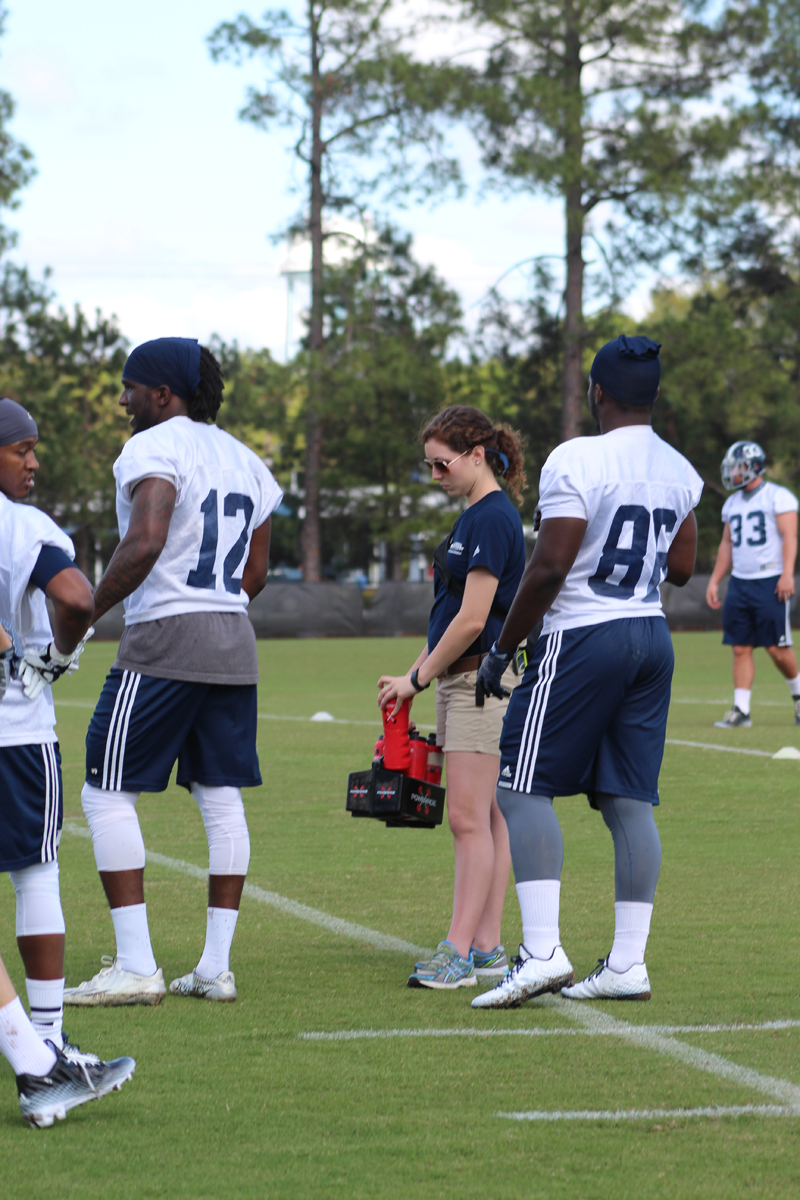A look behind the scenes of athletics
March 26, 2015
Often times, very important people are lost in the shadows of athletics. These people are always behind-the-scenes, and spectators do not pay much attention to them. But their role in whatever sport it may be is vital. A prime example of this is an athletic trainer.
Of course, there are certified athletic trainers. However, before somebody is able to reach that level, they must go through competitive schooling in order to learn all of the necessary skills.
Students in the athletic training program at Georgia Southern work long days, juggling classes and athletes. The day typically begins early in the morning and does not end until the late hours of the night.
Athletic trainers begin work around 5:30 a.m. each day, assisting athletes in whatever they need. However, those athletes will not arrive until an hour later. First comes the preparation – rehabs need to be written, ice bags need to be filled and tape needs to be lined up. Then comes the work – sore joints are looked at, general soreness is remedied and rehab routines are given.
These morning treatments, practices and workouts consume athletic trainers’ days. It is a life style that takes a lot of work and dedication. Sometimes it can be intimidating, and not everyone can do it.
The athletic trainers are always available before and after every practice. Most of the time, they are there an hour or so early and are the ones seen setting up and taking down the practice equipment. It is a job that requires a large amount of time and work that some students may not be able to handle.
However, spectators do not see all of this work. When someone is in the stands and sees a player get injured, athletic trainers jump into action with an on-field evaluation which can be intimidating. They are put on stage in front of the entire audience – all eyes on them.
“You think you’re going to forget everything, but then you get out there and your body takes over. It’s pretty cool,” junior athletic training student Nikki Renfroe said.
After the on-field evaluation ends though, everything happens behind closed doors. What no one else sees is the rehab process that begins with baby steps and typically ends in a full recovery.
Whether those baby steps include stretching or moving the injured body part or simply helping improve balance, the athletic trainer is there every step of the way. After increasing the difficulty of the routines, the athlete begins to progress and is able to return to normal. It all takes place but usually goes unnoticed.
It is a rewarding profession, however, even if most people do not realize and understand the process. The athletic trainers get to watch the rehab process and be there for every step along the way. It is an exciting time when an athlete is able to return to normal and get back in the game.
“You don’t always get a thank you. But being there at the moment to congratulate them or share in the experience and their excitement is just as exciting for you as it is for them,” junior athletic training student Holly Meese said.
“They typically don’t thank you on the spot, it’s normally at the end of the season when they come back and thank you because they were able to play again,” Renfroe said.
It is not all physical though. Sometimes the athletes are just having trouble dealing with the thought of not being on the field or court. Sometimes it is simply handling the frustrations of not being able to do simple tasks. That is when an athletic trainer becomes somewhat of a therapist. They begin to help the athletes with everything that comes along with an injury.
Many times, that is what it is all about. Athletic trainers do what they do because they want to help people. It becomes more than a job for them. They invest their lives in the athletes and trust is built between them.
“Most of us get into this profession because we want to help people and it’s our passion. We’re not really looking for anyone else to realize it. We are just doing what we love,” Meese said.
And the athletic trainers at Georgia Southern are especially lucky. Building trust with athletes is made a little easier because the athletes know that their athletic trainers will always be prepared. Georgia Southern has always made sure they have the necessary equipment to take care of its athletes. The resources that the university has are top quality and that helps put the athletes at ease.
“Sometimes, we have to tell them ‘If you try to play through this, think about what it could do in the long-term.’ That’s where the trust comes in. They have to trust that we have the resources to get them the help they need,” Renfroe said.
Athletic trainers are not only there to help with the injuries though. Sometimes, the most exciting part is getting to celebrate a win with the players they have invested so much time in. They are on the field or court to see the reactions of the players and coaches and get to share that special moment with all of them.
And rightfully so because that is their family. However, they also form a family amongst themselves as well. Athletic trainers spend every day together and always lend a helping hand whenever it is needed.
“You think we would get at each other’s throats, but we actually get along really well and we encourage each other. We all have a really good relationship and we can tell each other everything. We’re crazy weird with each other too,” Meese said.
It is one big family in the athletic training room. From the athletes to the coaches, from fellow trainers to the certified instructors, everyone works together to get the job done.
“Our instructors go above and beyond to help us. They become your parents. Having those relationships, even after you graduate, you know you’re in good hands,” Renfroe said.









